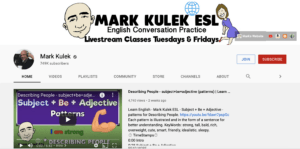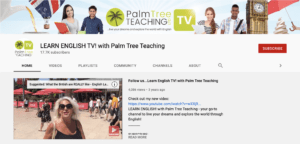Last month, BridgeUniverse explored the ways English language teachers and learners are using Instagram and TikTok. In this article, we’ll continue looking at English teaching outside the classroom by profiling several YouTube teachers who discuss their challenges and successes teaching on this social media giant.
English Language Education on YouTube
Given YouTube’s size, it’s no surprise that popular English teaching sites abound on what is possibly the second largest social media channel. Why “possibly?” Facebook still ranks as the largest, with 2.74 billion active monthly users in 2021, according to Hootsuite. But while YouTube counts 2 billion logged-in monthly users, it’s possible to watch YouTube videos without logging in, which makes those viewers harder to tally.
How prominently does education in general feature on YouTube? As with a notion like “active users,” it depends somewhat on how you slice it. Here, in order, are the top 16 categories of YouTube videos in 2021, according to Mediakix.
- 1. Commentary
- 2. Product Reviews
- 3. How-Tos/Tutorials
- 4. Top Lists
- 5. Comedy
- 6. Challenges
- 7. Reactions
- 8. Q&A
- 9. Interview
- 10. Docuseries
- 11. Educational
- 12. Music Videos
- 13. Narratives
- 14. Gaming
- 15. ASMR
- 16. Sports
A channel’s popularity determines how easy it is to monetize, although money is not the only reason that teachers set up and maintain a channel. But given the enormous amount of work that goes into creating a steady flow of content, the money earned can determine whether a channel becomes a full-time job or remains a side-hustle or a hobby.
However, while “Educational” ranks as the 11th most popular category, how would you classify a video about how to use the present perfect? Is that Educational or a How-to/Tutorial? What about a list of the top 20 sports metaphors in contemporary speech, followed by an interview with a sports figure? Clearly, categories blur.
A Busy Bee: The Power of Consistency
After a decade and a half of teaching on YouTube, one teacher reflects on the experience.
In 2007, when Jennifer Lebedev’s two children were young and she landed a book contract, she made the decision to leave the physical classroom with its set hours. Yet she wasn’t ready to give up teaching, which she loved. She’d already noticed people posting short videos on YouTube, but hadn’t seen anyone giving a full, traditional lesson — and so she stepped into that niche. Filming around her children’s naps and meals, she had no idea initially that it could ever become a full-time, paying career, and in fact, for the first few years, she provided all of her content for free.
The response was immediate, from comments on the channel to emails. From the beginning, she noticed that she was being followed not only by students wanting to improve their English but by teachers interested in everything from how she structured a lesson to how she provided explanations. “Teachers learn from teachers, but we don’t always have the chance to observe each other,” comments Lebedev.
Was It Easier Years Ago?
“Because hardly anyone else was posting at that time, it was easy to gain traction. And that’s the biggest difference in 2021. So thank goodness I started when I did because I didn’t have a lot of the technical skills to make my package very polished. But people knew that I was able to teach, and I had the content. And that was my promise to everyone: Thank you for watching, and if you keep watching, I will continue to learn.” It hasn’t always been easy, admits Lebedev, who has periodically struggled with equipment and sound issues, but a spirit of perseverance and willingness to troubleshoot and problem-solve has carried her through — on top, of course, of quality teaching.
At first, Lebedev based her lessons on topics she thought were pertinent, although she wasn’t following any sort of linear curriculum. Then she was approached by a prospective student who wanted private lessons. With no spare time, Lebedev asked the student if she would be willing to have the lessons filmed and put onto YouTube. That became “English with Jennifer”, lessons 1-65, starting from the very beginning, with “Hello. How are you?” Even those lessons were topic-based and deliberately non-scripted, as Lebedev’s goal was a natural, more free-form approach.

Jennifer’s YouTube channel homepage
Lebedev’s videos operate as stand-alones, but they are also organized into playlists — you can find a writing playlist, for example, or a pronunciation playlist – and these operate like mini-courses on a certain topic. She expects serious learners who want to master a skill or grammar point to watch the videos on a given playlist in sequence. While all her videos are available on YouTube, she’s archived some of the earlier, lower-tech videos into a separate section. That still leaves over 600 videos in the main section, however. While a sizable portion of her content is free, paid subscribers can access additional content.
Is YouTube Alone Enough?
While YouTube is Lebedev’s main platform, she’s active in other places as well. She tried both Twitter and Facebook, and while she maintains accounts there, they didn’t fit her style as well as Instagram, on which she’s also been active for a few years. Instagram has been a good place to connect with other teachers. “It’s been interesting to build my professional network that way, connecting with other teachers, especially the younger ones. As I get older, I realize I need to stay in touch with everybody up-and-coming behind me, to stay relevant, and it’s been wonderful to connect with the younger teachers who are building names for themselves and adding a lot of good content.”
Lebedev posts one video a week on Instagram and a different one on YouTube. Because videos on Instagram are limited to a minute, she concentrates mostly on listening and speaking as well as on cultural information. Devoted followers know Lebedev’s posting schedule on multiple channels, although plenty of viewers stick to the social media they prefer.
How Long Does It Take to Produce This Much Content?
It’s a time-intensive process. Lebedev estimates that every minute of video content takes about an hour to produce — from idea to script to lighting, filming, converting, editing, captioning and finally to uploading. Although automatic captioning programs do exist, they’re not precise enough for English language teaching, especially for her live lessons involving lower-level speakers. Then there are the comments and questions, which Lebedev tries to respond to within 24 hours — which means that she’s answering viewers every day. Every day? Yes—7 days a week, 365 days a year.
Lebedev, who now teaches exclusively online, doesn’t feel she’s in any danger of running out of material. “There’s just so much I still want to cover,” she says, holding up a several-inches-thick wad of notes on colored paper. “This is my idea stack of things I want to do.”
How Does a YouTube Channel Make Money?
YouTube monetizes a channel by posting ads on it when it hits 1,000 subscribers. While the money at first didn’t seem all that substantial, it grew over time as Lebedev’s subscribers increased. While ads alone are not enough to constitute an income for her, the YouTube channel can be leveraged in other ways. In 2008, thanks to the popularity of the channel, Pearson approached Lebedev about blogging for them, which she continues to do (https://englishwithjennifer.wordpress.com/). In 2009, Lebedev posted an ad for private students, and in less than 24 hours, had enough to get started. Since then, she’s never lacked for students. They provide a constant source of income, and in addition, she genuinely loves teaching them and enjoys the online interaction. Via her Patreon account (a platform for creatives to find “patrons”), subscribers can pay for different tiers of instruction, from group lessons to private lessons.

Jennifer’s blog homepage
How Much Interaction With Students Is Possible?
From the beginning, Lebedev has been open and easy to contact, whether through email or the comments section. These days, she notes, YouTube has given creators the ability to filter certain words as a protection against both spam and bullying – protection she didn’t have at the beginning, though she’s always been able to delete inappropriate comments and block commenters. However, if a viewer has a legitimate criticism, she’s willing to listen and respond to it. For example, she’s sometimes asked why she speaks slowly in her lessons for beginners, a practice she says she’s both aware of and stands behind, though she notes that she also varies her speed — slower for comprehensibility, and faster for chunks she feels her learners are familiar with. “I’ve explained to people on numerous occasions, if you criticize my speed, it’s because you’re ready to go on. So go on to the next-level video. Because this is an ESL video, and I am building the bridge to comprehension. Not everybody wants to hear a fast explanation about stative passives.”
Is There a YouTube Community of Teachers?
“Another nice thing that has happened over the years is the rise of non-native speaking teachers … native speakers are not the only answer. Native or non-native, you need qualified people.”
While she doesn’t have time to follow other teachers herself, she does check in with friends, and from time to time participates in events with other YouTubers, so she’s aware of the YouTube teaching community. Over the years she’s witnessed the rise in popularity of more varieties of English and more accents — not just American or British or those from Australia and New Zealand. “Another nice thing that has happened over the years is the rise of non-native speaking teachers, and I’ve really done what I’m able to do, especially through live events, to support them, to erase myths, and I feel committed to doing that—to saying that native speakers are not the only answer. Native or non-native, you need qualified people.”
What’s Next?
When she hit 100,000 subscribers, YouTube gave her a plaque, and Lebedev has heard there’s another plaque for channels that hit the million-subscriber mark. At 956,000, she doesn’t have far to go. “I’d like to get there,” laughs Lebedev. “It would be a nice milestone. Maybe in a year or so. But I love what I do. I’m like a busy little bee in my garden. I feel like my greatest accomplishment is being a working mother and keeping it all going.”
Going Global From Japan: Learning From YouTube’s Algorithms
Some teachers plan to teach online, and some come to it almost accidentally.
American Mark Kulek, who’s lived in Japan since 1996, started with his own English school there, giving classes to children. One day eleven years ago, while driving, he was listening to a podcast about someone else’s YouTube channel. Intrigued, he checked it out when he got home, and thought, “I could do that.” So to complement his lessons, he set up a tripod and filmed himself using the same materials, such as flashcards and pattern drills, on his whiteboard. That way, students could watch his videos at home to review what they’d done in class, and parents could see what was being taught.

Mark Kulek, an English teacher and YouTuber
However, although he’d intended the videos only for his own students and their families, learners and teachers from other areas began following him as well. He first became aware of the extent of his growing reach when YouTube notified him, about a year after he had been posting, that several of his videos had become popular, and invited him to monetize them by joining what was then called the Partnership Program. This added another layer of incentive, as he then branched out into more general English teaching. Eventually, he was making enough money through his YouTube channel, and taking so much time to create and maintain it, that he closed his school, although he still works part-time at two Japanese universities.
Since the YouTube algorithms reward frequent as well as consistent posting, he increased the number of videos he posted, moving from the two or three videos a month he’d posted for his own classes, to a mix of live-streaming three times a week and shorter, static videos on the other days, which are then archived. Currently, he’s posting ten videos a week. To maintain this schedule, Kulek plans and films well ahead, often a month or more, working on several videos at a time to streamline the process, working on weekends, holidays and during the summer break from his university jobs.
From Where Do You Get Your Ideas?
A classroom language teacher, of course, can repeat the same lesson with a new class. On YouTube, a teacher needs a constant source of fresh material. Does he ever feel like he’ll run out of ideas? Kulek laughs. “That’s the thing about language, you know? It’s infinite. I have books and my dictionary … I look for patterns and topics, and approach things from a different angle.” Kulek’s pre-recorded videos generally range from around three to 10 minutes long, but his livestreams last from one to two hours. For these, he has set routines that he incorporates each time, which his viewers can easily follow because they know the patterns. He teaches as if he were addressing a live audience; for example, he conducts pattern drills by speaking one part and leaving a pause for viewers to repeat or type the answer in the chat. An average of 100-200 people follow his livestreams, and then thousands more watch them later. Learners can even buy books based on his routines, for further reinforcement. In Japan, he evens sells his own set of companion flashcards.
Because his content is evergreen — meaning timeless content that remains relevant for long periods of time — viewers find his channel when YouTube recommends it or just by searching. (YouTube is, in fact, the second largest search engine, processing over 3 billion searches a month; only Google, which owns YouTube, is ahead.) One thing that surprised Kulek was how many teachers follow him. With over 1,000 videos, teachers find content to show students in their classes or to assign for homework. He’s heard from teachers all over the world, and even school boards in South Korea and Colombia.

Mark’s YouTube channel homepage
With over 100 comments a day, Kulek does admit that responding can sometimes feel overwhelming. And yet he does — to every single one. “They’re your people, you know? They’re your audience. In spare moments, I take out my phone and answer some comments … I have no downtime.”
Kulek also maintains a Facebook group page where he posts new YouTube content and photos of the notes on his whiteboard from his livestreams. Although advertisements provide about 95% of his revenue, Kulek also has paid YouTube channels, which charge users a low monthly fee in exchange for increased content. Kulek thinks the paid channels benefit the viewers by increasing their motivation to log in and participate, much in the same way people are more likely to go exercise at the gym if they pay for a membership.
What Are Some of the Challenges of Maintaining a Channel?
Have there been any speed bumps along the way? Kulek relates one incident early on when YouTube halted his ads because he was using clip art from a disk he’d purchased. However, while the images were legal to use in his personal classroom, they were not licensed for commercial use online. Kulek solved that problem by finding his own artist who now illustrates all of his materials, and who — as an added bonus — creates drawings that are specifically what Kulek would like for a lesson.
“Last year was my best year,” says Kulek, crediting the pandemic with the increase in people looking for online education. But then in March of 2021, something happened. What, he’s not exactly sure, but he saw his views drop, and drop, and drop, and felt helpless to reverse the trend. He suspects it had something to do with a tweak in the YouTube algorithms. With the drop in views came a corresponding drop in impressions — YouTube’s term for showing a thumbnail of your channel for at least one second. And when impressions fall, so do views, thus creating a downward spiral.
So Kulek reached out to a fellow YouTubing friend to help him brainstorm, who suggested he try some very short videos, around one minute long. And so he did. He had recently painted one wall of his office a cheerful green, so he moved in front of the green wall and started recording one-minute videos based on phrases. Previously, he hadn’t been posting on Sundays or Wednesdays, so the new format gave him an achievable way to post content every day. It’s working, and his channel views are rising again. He suspects it’s not necessarily new viewers, but rather people who are fans already who are now coming every day — an action YouTube rewards. As of June 2021, Kulek had over 745,000 subscribers.
What’s Next?
“YouTube is very clever. It’s like the carrot and the stick. If you get too confident or complacent… you have to up your game … the AI, the algorithm, keeps changing as a way to keep you on your toes and constantly improving.”
Kulek has no plans to stop YouTubing anytime soon. “I like the lifestyle,” he says, and although there can be setbacks like the one he experienced in March, he sees an upside to that too: “YouTube is very clever. It’s like the carrot and the stick. If you get too confident or complacent … you have to up your game. When my channel started losing views, that forced me to make a change, and that change made my channel stronger. And in the long run, I’ll do even better. YouTube wants everything to get better. So the AI, the algorithm, keeps changing as a way to keep you on your toes and constantly improving.” If anything, Kulek wouldn’t mind working one day a week less at his university jobs — so he can devote even more time to YouTube.
The Tough Decision to Keep On or Move On
Some teachers turn to YouTube to meet specific learners’ needs.
When Deirdre Nichols left her post at the British Council in Algeria to return to her native England in 2017, she couldn’t stop thinking about the students she’d encountered during her years there who didn’t have easy access — or sometimes any access — to schools or training centers. She was also being contacted on Facebook and through email by people she’d met there who begged her to teach them English. “So I’ll just do it online!” she said, and in 2018, her YouTube channel, “Learn English TV!” was born, as part of her Palm Tree Consultancy, which also comprises teacher training, tutoring, leading study abroad trips to the UK, and other education-related activities. She didn’t initially have any thoughts of making money from YouTube; she just wanted to meet a need.

Deirdre Nichols, the founder of the YouTube channel “Learn English TV!”
As an added bonus, she really enjoyed creating the videos. Assisted by her husband with the technical side, she started off by doing one video a week, and then to gain more traction, she went up to twice a week, increasing subscribers and showing YouTube she was a consistent poster. “And that was a big commitment,” she says. “You couldn’t have a proper full-time job in addition to that.”
What Are the Steps in Creating a Video?
A good lesson starts with a good topic. Nichols based her lessons both on what people asked for and what she found was ranking on YouTube in terms of search engine optimization (SEO). She’d use various apps to research what topics and videos were trending on YouTube, and also what other YouTubers were posting, with the goal being to capitalize on what people wanted but not duplicate other creators – an intellectual challenge she enjoyed.
To create a 10-minute video, Nichols would spend an hour or two choosing a topic and planning her lesson. Then she wrote a script and memorized it, which took a few more hours. Her husband Scott would review it, they’d discuss where they were going to film it, and then came three hours of filming, which included several takes. Scott then imported all the footage to his computer and edited it into a smooth, coherent video. Finally, he’d add music and any necessary text. Altogether, it would take Scott two days to create the video, after which Nichols would review it, and they’d finalize the video. Then she’d upload it to YouTube, research and add the SEO-optimized tags, and publicize it on Facebook and through her email list, which was altogether about another day of work. In addition, after the video was posted, there was time spent responding to comments and emails.
Why Do Some Channels Not Make Much Money?
While the videos were personally satisfying to create and she received enthusiastic responses from her viewers, the money just wasn’t coming. Her large base of fans in North Africa wasn’t able, because of currency restrictions, to pay for things like subscriber channels or private lessons. And while she had monetized the channel with ads, it wasn’t quite large enough to pay well. “It depends what field you’re in, how much you get from ads. If you’re in education, they can’t put very expensive ads onto your channel,” Nichols explains. “If you have a channel with content related to computers or airlines or fashion, and they can put higher-paying ads on your channel, and you can get more revenue. I’d get things like Babel or Grammarly, which didn’t pay as much. As an education channel, you’d need a massive amount of subscribers.”

Deirdre’s YouTube channel homepage
At the same time, though, Nichols found her other services much in demand, and so with some regret, she stopped posting new videos in 2020. The previous ones, all 99 of them, are still there, and she’s maintained some 17,200 subscribers, but she’s not posting new content. She’s noticed that her most popular videos now are those on teacher training, notably one on warmers and icebreakers, which had 163,000 views, and one on lesson planning, with 63,000 views so far. However, she wasn’t confident that a purely teacher-training channel would pay its own way sufficiently to compensate for the time necessary to create the videos or to compete with her other higher-paying services.
What’s Next?
Her channel did give her some non-monetary benefits, however. For one thing, it afforded her extensive practice speaking and teaching in front of a camera, which came in handy during a 2020-2021 project she worked on, training middle school and secondary school English inspectors in Algeria, all of which had to be carried out online. While some teachers felt apprehensive teaching on Zoom when the pandemic moved so many classes online, especially in situations where learners’ cameras might not be turned on, for Nichols, it was second nature. She’s also not turned her back on YouTube, and in fact has just started a new channel, “50 and Fabulous with My Friend Deirdre,” which covers fashion and style for mature women. Good teaching is good teaching, after all, no matter the topic.
A Supporting Role: Using YouTube To Help Drive Your Primary Business
In addition to those teachers who use other platforms to support their YouTube channels are those teachers who use YouTube to support their other endeavors.
Hugh Dellar, who together with Andrew Walkley runs the Lexical Lab, which offers online teacher training and, in non-pandemic times, in-person summer courses in London, started the Lexical Lab YouTube channel a few years ago. Initially, he’d intended to just have it promote their summer courses. Then, he explains, “I realized it might be nice to collate all the various videos of conference talks and so on that we’d done, and so I started playlists for that kind of thing. I moved on to doing the ‘ONE-MINUTE ENGLISH’ videos, which is now the main driver of the channel, about two years ago.”

Hugh Dellar, together with Andrew Walkley, runs the Lexical Lab
How Do You Decide What to Post?
The content mainly comes from students. “I do the ‘ONE-MINUTE ENGLISH’ videos three times a week and base them on items that have come up in my classes that have caused problems or that have been new for my students. This almost always means some kind of chunk or phrase or expression or idiom common in everyday speech, but rarely taught in coursebooks,” explains Dellar. Despite their title, the “ONE-MINUTE ENGLISH” videos are usually two to three minutes long and focus on one expression.
About his creation process, Dellar explains, “I’m very much a one-take kind of guy. I squeeze the making and uploading of these things in around a busy teaching schedule. I guess making the video takes me twenty minutes, max, five minutes to make a front image, and then 10 minutes to upload and tag and everything. An hour in total at the absolute limit. I have to choose the item, think of the story I’ll use to explain the meaning, think of some other examples to share, record it; then find a free image I can use as the front image; then upload the video and think of how to describe it.”
The “ONE-MINUTE ENGLISH” videos form a nice bank of language for the Lexical Lab learners to access, where Dellar can relate anecdotes and stories to illustrate items to which a dictionary would only give a meaning. The videos can deliberately recycle language and can be listened to with or without subtitles, which gives variety and flexibility.
How Do You Interact With Viewers?
Dellar engages with viewers by asking them to add their own examples of language in the comments section, and makes sure he responds to all comments and questions posted. Dellar is known online for being firm in his convictions about both teaching and language. Asked if he’s ever had a video flop or elicit negative feedback, he says, “Not really. Certainly nothing that’s caused any kind of controversy or elicited any major kickback; certainly not in the way that some blog posts like my piece railing against native speakerism did!”
How Many People Does This Approach Attract?
Although the channel currently has around 5,800 subscribers, Dellar notes that it has grown dramatically in the past half-year, even without him taking any special action to increase subscribers other than maintaining a consistent format and look, tagging the videos and including an extended description. He also shares new videos on his social media channels.
“None of my videos have exactly gone viral,” Dellar says. “I’m lucky if a video ends up with 1,000 views at the moment, though some of my more controversial conference talks have hit around the 10,000 mark now.” (Many of Dellar’s conference talks are also posted on the Lexical Lab channel.)
What does a channel like that bring in? “We get around £100 a month from advertising revenue. Small-scale stuff, but slowly growing. Maybe the occasional lead to the site, which results in the sale of an online course of some kind too, but I don’t track it or anything.” Instead, the site functions more as support for existing students of Lexical Lab.
Is YouTube Teaching Here to Stay?
According to YouTube, more than 500 hours of content are uploaded to the platform every minute.
According to YouTube, more than 500 hours of content are uploaded to the platform every minute. Not all of it is related to learning English, of course, but there is a large and active community of both teachers and learners on the platform. YouTube lets teachers present what they want, when they want, and how they want, and earn money doing it. While it’s no easier than teaching in a traditional classroom, it’s a different format that suits certain teachers well. From the learners’ perspective, YouTube offers a wealth of free or reasonably priced content, which they can watch over and over again, on their own schedule. While it’s unlikely that YouTube will ever replace in-class teaching entirely, it’s clearly an important space in the educational field.











